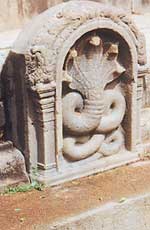|
Gaveshaka
takes a walk round the ‘vata vandanawa’ He had been so impressed after seeing it during an early visit to Sri Lanka that he had kept a photograph of the statue. On a later visit during the Buddha Jayanthi celebrations too, he went to Anuradhapura and spent some time near the Samadhi statue. In the early days when transport was scarce, pilgrims to Anuradhapura used to do the ‘vata vandanava’ by foot. As the name suggests, it was a circular route where they could visit the Atamasthanaya - the eight sacred places of worship - in Anuradhapura. Apart from the stupas and other religious buildings, pilgrims would see the intricate architectural masterpieces like the famous ‘sandakadapahana’ - the moonstone. In simple terms, it is a semi-circular stone doorstep intricately carved with figures of animals and birds. There are several characteristics of a moonstone. There is a half-lotus in the centre enclosed by bands which are decorated with a band of geese, an intricate foliage design, a procession of four beasts - elephant, lion, horse and bull, racing each other - and a band of stylised flames. These different elements are blended into a beautiful design, quite unique to Sinhalese architecture. These are considered to be an outstanding architectural and artistic creation of the ancient Sinhalese in the Anuradhapura period. Beautifully carved ‘pun kalas’ (pots of abundance) adorn the entrances to the ponds on either side leading to flights of steps going down to reach the water. Water supplied through underground conduits was first conveyed to stone chambers or silt traps from where it was filtered before flowing into the ponds. The monks had bathed in these ponds. It is likely
that the embankments enabled them to bathe using pots or other utensils. |
||||
Copyright © 2001 Wijeya Newspapers Ltd. All rights reserved. |
 Most
of you, if not all, may have been to Anuradhapura and admired what
has been accepted as the finest Samadhi image in Sri Lanka. The
great Indian leader, Prime Minister Pandit Jawaharlal Nehru has
put down on paper that he found solace by looking at a photograph
of this statue while in prison after he was imprisoned by the British.
Most
of you, if not all, may have been to Anuradhapura and admired what
has been accepted as the finest Samadhi image in Sri Lanka. The
great Indian leader, Prime Minister Pandit Jawaharlal Nehru has
put down on paper that he found solace by looking at a photograph
of this statue while in prison after he was imprisoned by the British. The
most serene Buddha statue is believed to have been built around
the third century BC and has been sculptured out of dolomite. It
belongs to the Gupta tradition both in style and execution. It is
possible that the eyes were originally studded with gems. The figure
may even have been painted.
The
most serene Buddha statue is believed to have been built around
the third century BC and has been sculptured out of dolomite. It
belongs to the Gupta tradition both in style and execution. It is
possible that the eyes were originally studded with gems. The figure
may even have been painted.  Then
one also comes across ‘mura-gala’ or guardstone carved
out of stone at the entrance to a building or a stupa. They are
generally on either side of a flight of steps.
Then
one also comes across ‘mura-gala’ or guardstone carved
out of stone at the entrance to a building or a stupa. They are
generally on either side of a flight of steps.